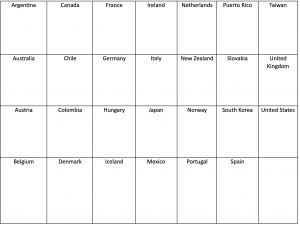The R&D tax credit is one of the largest annual tax credits available to U.S. companies. For companies who qualify, it’s basically a reward for doing business as usual.
The credit was introduced in 1981 as a way to incentivize companies to keep high-paying jobs in the U.S.
At its inception, a company had to create or produce a new product or process to qualify, which meant only a few cutting-edge companies could benefit. New regulations have been introduced and now, “research and development” seems a lofty term for what the credit really rewards: improvement.
After all, you don’t have to cure cancer or create a Covid-19 vaccine to qualify, you just have to make something better: a product, a process, a formula, software.
“After all, you don’t have to cure cancer or create a Covid-19 vaccine to qualify, you just have to make something better: a product, a process, a formula, software.”
Why Offer R&D Tax Credits?
At least 75 jurisdictions around the world (countries, states and provinces), offer R&D tax credits to incentivize companies to keep high- paying jobs within their borders. Why? R&D hubs boost economies— companies hire employees, invest in real estate, and spend money.
A generous tax credit helps attract entrepreneurs and their big economic injections. However, the actual benefits and qualifications vary from one jurisdiction to the next. In the U.S., approximately 38 states offer R&D tax credits and even those qualifications and rewards vary.
Jurisdictions that Offer R&D Tax Credits

- CAN – Alberta
- CAN – British Columbia
- CAN – Manitoba
- CAN – New Brunswick
- CAN – Newfoundland and Labrador
- CAN – Nova Scotia
- CAN – Ontario CAN – Quebec
- CAN – Saskatchewan
- CAN – Yukon
- USA – Alabama
- USA – Alaska
- USA – Arizona
- USA – Arkansas
- USA – California
- USA – Colorado
- USA – Connecticut
- USA – Delaware
- USA – Florida
- USA – Georgia
- USA – Hawaii
- USA – Idaho
- USA – Illinois
- USA – Indiana
- USA – Iowa
- USA – Kansas
- USA -Kentucky
- USA – Louisiana
- USA – Maine
- USA – Maryland
- USA – Massachusetts
- USA- Michigan
- USA – Minnesota
- USA – Nebraska
- USA – New Hampshire
- USA – New Jersey
- USA – New Mexico
- USA – New York
- USA – North Dakota
- USA – Ohio USA – Pennsylvania
- USA – Rhode Island
- USA – South Carolina USA – Texas
- USA – Utah
- USA – Vermont
- USA – Virginia
- USA – Wisconsin
U.S. R&D Tax Credit Gamechangers
The Discovery Rule goes away
The IRS began to cast a larger R&D net, starting with the elimination of the “Discovery Rule” in 2003.
The Rule mandated that R&D activities must be “new to the world.” Without it, activities only have to be “new to the taxpayer,” which has paved the way for more companies—and more industries—to qualify for the credit.
The R&D tax credit becomes permanent
When the R&D tax credit was introduced, taxpayers often had to wait and see if Congress would renew the credit before they could file claims. For many companies that meant putting important spending decisions on hold.
That became a non-issue in 2015, thanks to the Protecting Americans From Tax Hikes Act, or PATH Act, which made the credit permanent.
Start-ups benefit
Years ago, companies operating at a loss weren’t able to immediately monetize the federal R&D tax credit because they weren’t taxable. The PATH Act made a huge impact once again: Now companies with average gross receipts for the last three years that don’t exceed $50 million can use the R&D tax credit against their AMT liability.
Offset the Alternative Minimum Tax (AMT)
Before the PATH Act, taxpayers could only use the R&D tax credit to offset their regular income tax liability.
Those saddled with a steep AMT, amounting to more than the regular tax liability couldn’t use the credit. If the regular tax liability was a little more than the AMT, they could only use the credit to reduce to the amount of the AMT.
The PATH Act made a huge impact once again: Now companies who have earned on average $50 million or less in gross receipts, over the last three years, can use the R&D tax credit against their AMT liability.
A new way to qualify
In 2006, the IRS and the U.S. Department of Treasury introduced the alternative simplified credit, which is a simplified way to calculate the R&D credit.
Using this computation, companies that may not have been able to claim their credit had a new avenue available.
Tax Cuts and Job Act increases the credit
In 2018, the Tax Cuts and Job Act (TCJA) reduced the corporate tax rate from 35 percent to 21 percent. Taxpayers claiming the reduced R&D tax credit saw an increase in the impact of their credit.
The Opportunity
The amount you can claim and how you receive it—loans, cash grants, tax credits—depends on the country.
In 2014 (the most recent available information), the IRS reported 17,824 taxpayers claimed more than $12 billion in federal R&D tax credits in the U.S.
The credit ranges state by state and is generally between six to 14 percent of your qualified spend. So, if you have $1 million in spend, you could be entitled to a $60-$140k credit.
And yet, only five percent of companies that qualify for R&D tax credits actually claim them.
- 17,824 The number of taxpayers claiming R&D tax credits in 2014
- $12 billion The amount of federal R&D tax credits claimed in the U.S. in 2014
- 5% The percentage of qualified companies that actually claim R&D tax credits.
R&D Tax Credit Requirements
Contrary to popular belief, a company doesn’t need a lab full of scientists and microscopes to qualify for R&D tax credits. In fact, for consideration, an activity only has to meet four simple criteria.
R&D Tax Credits Criteria
1: Attempt to develop a new or improved product, process, software, technique, invention, or formula: The effort must attempt to increase performance, function, reliability, or quality. However, the company doesn’t need to actually achieve improvement or invention. Even if their efforts fail, they can still qualify just for making the attempt. For example, a software developer could set out to build software that enhances the user experience with a new feature but fail to actually build that feature.
2: Rely on hard science: Hard science refers to engineering, physics, chemistry, biology, or computer science.
3: Eliminate Uncertainty: The activities must be meant to eliminate uncertainty concerning the capability or method of developing or improving what was sought out or the appropriate design of it. In other words, a company might not know whether or how they can develop a product or not know the design of it at the start, but their efforts should seek to clarify that direction.
4: Require Experimentation: Activities have to go through some experimentation to eliminate or resolve the technical uncertainty. The process involves an evaluation of alternative solutions or approaches and is performed through modeling, simulation, systematic trial and error, or other methods.
Qualified Companies
Companies that do any of the following activities should apply for the credit:
- Develop or design new products, including software
- Improve existing products or processes
- Develop patents or intellectual property
- Research that could lead to newknowledge
Qualifying Expenses
- Employee salaries
- Supplies
- Computer leasing
- Contract research
Eligible Industries
Businesses in hundreds of industries can qualify for the credit.
Here are just a few:
Technology: Enhancing or developing new functionality can qualify—that means the credit is open to software development, app development, telecommunications, and electronics.
Manufacturing: Designing new parts, developing new or improved production lines, reducing waste, and designing packaging all fall under the R&D umbrella.
Engineering: It takes a lot of research to create new designs, products, and prototypes—and we haven’t even mentioned the testing that goes along with it.
Life Sciences: You can bet a field that creates medical devices and pharmaceuticals spends a lot of time researching, developing, and testing. But a business doesn’t have to give birth to something completely new to qualify for the credit—lengthening shelf life or testing new chemical compounds can qualify.
Surprise—You Qualify, Too!
If you work in any of the following industries, you might want to start documenting your projects and expenses—there could be an R&D tax credit in it for you.
- Automotive
- Consumer goods
- Aviation & Aerospace
- Retail & eCommerce
- Food & Beverages
- Medical devices
- Biotechnology
- Oil & Energy
- Financial services
- Telecommunications
- Renewables & Environment
- Apparel & Fashion
- Logistics & Supply Chain
- Craft beer companies
- Cannabis companies
- Farmers & agriculture
- Advertising/Marketing analytics
- Logistics
How to Claim R&D Tax Credits
Qualifications vary from jurisdiction to jurisdiction—even state to state— but here’s the big picture.
R&D Tax Credit Reports Can Include
- An overview of the company
- Activities that the company performs
- Project analysis
- Quantitative information like expenses, gross receipts, and revenue information
- Credit calculation
BEWARE:
Requirements like these vary, depending on the jurisdiction.
Thresholds Forms
Pre-certifications Paperwork
R&D Tax Credit Supporting Documentation Includes
- Requirements
- Specifications
- Project lists
- Project notes
- Contracts for R&D
- Design Drawings
- Design Requirements
- Design Specifications
- Internal presentations
- Management Notes
- Patents
- Project Plans
- Project Status Summaries
- Prototype Drawings
- R&D Budgets
- Test Plans
- Test Results
The Benefits of Claiming R&D Tax Credits
- It’s instant cash. For many small and mid-sized companies, the R&D tax credit is money you can re-invest right away.
- It’s a dollar-for-dollar credit. The R&D tax credit isn’t a tax break— it’s a dollar-for-dollar credit against taxes you owe or taxes you paid.
- You can benefit now and later. You can reduce your current— and future—state and federal tax liabilities.
- It’s widely available. In 2014, more than $12 billion in U.S. federal credits were given out – this number has surely grown over the last six years. About 80 percent of that goes to the country’s largest companies. Don’t you want in?
- Credits can carry forward 20 years. And you can take the credit for all open tax years—usually the last three or four years, plus the current.
- Reduce payroll taxes. Even if you’re operating with losses, you can use the R&D tax credit to offset some of your payroll taxes.
Challenges of Claiming R&D Tax Credits
Documenting
For many companies, the challenge of claiming R&D tax credits isn’t qualifying—it’s documenting that they qualify. That documentation is a big ask.
Companies have to show the nexus between qualified expenses and qualified activities, which means gathering mountains of data: payroll records; ledgers; project notes; requirements; specifications; gross receipts; revenue information.
Difficult documentation is one reason why most companies choose to outsource the work – either to a consultant or to a technology provider like Exactera. Both solutions get the work done but working with a technology provider is often less expensive and more organized and accessible than working with consultants.
Keeping track of changing regulations
R&D tax credit qualifications vary from jurisdiction to jurisdiction and often change. You’ll have to be on top of those requirements—and adhere to them–wherever you’re innovating.
If you’re working with a consultant, you’ll often need to engage a new firm to claim R&D tax credits in every jurisdiction where you have operations. Most accounting firms specialize in a single country. With a technology- based solution like Exactera, all requirements for every jurisdiction around the world are handled by a single product so you can complete your documentation with a single provider.
Calculating the credit
Calculating the credit is trickier than it sounds—it’s usually a manual process that lives in Excel. The rules and regulations that impact the credit are complex. For instance, rules around the base period or controlled groups mean you can’t just plug a few numbers into a static Excel template.
Addressing the nuances of each credit calculation requires an understanding of the rules and their impact. Accounting for them is often a manual process (e.g., manual changes to that Excel template).
When using a consultant, that complexity is captured in the hours you’re billed. More time means a higher cost at the end of the project. AI is an efficient alternative. Technology-based solutions like Exactera’ tax suite are built to include the rules for every jurisdiction around the world and complete the correct calculations automatically so time doesn’t factor into the end result…or your bill.
Supporting the claim with contemporaneous documentation
Documenting your projects adequately means documenting in real- time. Often companies look back on R&D projects and try to piece together important facts and circumstances. Documenting in this way is difficult because employees may forget important information or key individuals may leave the company, leaving organizations with poor supporting documentation.
Organizing reports in one place
Wherever a business claims R&D tax credits, there is going to be a lot of paperwork. Organizations need a centralized place to store reports, workpapers, and notes and it needs to be organized so it can be referenced again next year.
When working with a consultant, relevant reports and supporting documentation are often delivered via email. Technology-based solutions offer a built-in repository of all of your relevant documentation so there’s no question that you’ll have what you need when you need it.
Technical expertise
The person preparing the R&D tax credit documentation often isn’t an expert on, say, developing software or concocting cutting-edge drugs. Creating the documentation requires talking to technical engineers to capture the nature of the work within the documentation.
The expense
Claiming R&D tax credits is usually farmed out to consultants who somehow feel entitled to a percentage of your credit. And if you’re claiming in more than one jurisdiction, you’ll likely pay a consultant in each one.
Technology-based solutions cut out the most expensive piece of claiming R&D tax credits – the hours of preparation. Because the software does the work, AI-based providers like Exactera can charge a predictable, flat fee to claim R&D tax credits in every jurisdiction where you have operations, globally.
“For many companies, the challenge of claiming R&D tax credits isn’t qualifying— it’s documenting that they qualify”









